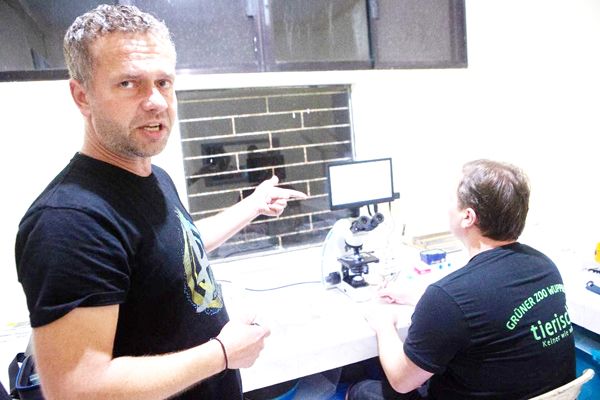DAVAO CITY – European raptor experts are now collaborating with the Philippine Eagle Foundation to boost its conservation efforts for the critically endangered national bird.
Dr. Jayson Ibañez, PEF Director for Operations, said that Dr. Jan Hanel, Curator of Birds from Liberec Zoo in Czech Republic, and Dr. Dominik Fischer, Curator for Science at Der Grüne Zoo Wuppertal in Germany, are now imparting game changer tools and techniques with PEF’s staff to further enhance their capabilities in breeding and conservation programs.

DR. Jan Hanel (left) explains the capabilities of the video microscope with his colleague Dr. Dominik Fischer. (Keith Bacongco)
Ibañez said the effort is a collaboration with the Liberec Zoo and the Raptor Technical Advisory Group (TAG) of the European Association and Zoos and Aquaria to modernize conservation breeding techniques for the critically endangered Philippine Eagles through cooperative artificial insemination (CAI) and semen cryopreservation and optimization techniques.
In an interview, Fischer said that they have introduced tools to assess the quality of any semen it collected from male eagles through sperm and motility counts.
He added that they also introduced tools and techniques to prolong the shelf life and maintain high quality semen through the use of diluents or extenders to make it available for any imprinted female eagle that is ready to breed.
Ibañez said that the experimental dilution and cryo freezing and thawing of semen from Philippine Eagle “Sinag” proved that their procedures were very successful at reviving active sperm cells after only a few minutes of thawing.
Using a top of the line video microscope and accompanying software application, the German veterinarian said that it can provide accurate data on the quality of the eagle’s semen.
Hanel said that with this technology, it could help assure the PEF that it has indeed collected fertile semen from its male eagles before the artificial insemination.
During initial tests, he said that results from semen samples yielded a very positive result, with one specimen recording an 86 percent fertility rate. “That’s a very positive result. We are confident that it can produce an egg in the future.”
Ibañez said that this collaboration with European counterparts will be a game changer for the conservation breeding and species reintroduction programs. “They are in for the long-haul, which is very important for any endeavor that seeks to reverse the extinction crisis for threatened species.”
He said that part of the partnership was the donation of top of the line Europe-made equipment conservation breeding equipment worth $25,000 or about P1.4 million.
The equipment package include digital and WiFi-compatible artificial incubators for hatching eagle eggs in captivity, digital brooder and intensive care unit (ICU) for newly hatched eaglets, digital egg and chick weighing scales that can also automatically detect heart beats in eggs, video microscope with high-definition monitor, and 3D printed hypoallergenic dummy eggs that eagles can temporarily incubate while their real egg is being examined by PEF staff.
Fischer, president of the European Association of Avian Veterinarians, said that the electronic microscope was donated by the Friends of the Zoo Wuppertal Association with a special discount and support from Zoetis in Germany.
The Olomouc Zoo and Zoo Nehvizdy donated the digital scales, other mini-equipment, and materials.
Ibañez said that the experts will also help pilot the use of falconry-based techniques for the rehabilitation and future release of eagles back to Leyte to avoid what has happened to “Uswag.”
Uswag, a male Philippine Eagle, crash-landed at sea and died on July 30, just a month after its release in Barangay Kagbana, Burauen, Leyte. Its carcass drifted and was recovered near Ponson Island in Cebu on August 3.
The PEF official said that Uswag, a juvenile eagle, was not yet as agile flyer like his wild counterparts.
“Falconry techniques will ensure that any bird released will get adequate muscle and flight training and experiences in air. Maneuvers in a controlled and safe environment before it is set free on its own in the wild.”
Hanel said that falconry techniques would be very helpful for captive-bred eagles that would be released into the wild in the future.
Calling it as an “end-to-end” approach, Ibañez said, it covers all aspects of the program such as captive breeding, community education and training, release, and post-release monitoring.
The PEF said there are 392 pairs of Philippine Eagles left in the wild.